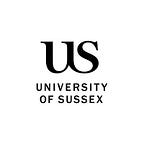“We need to understand what digital learning means in the new landscape”
Professor Claire Smith is Head of Anatomy at Brighton and Sussex Medical School and the new Deputy Pro-Vice Chancellor for Education and Innovation, leading on the Learn to Transform section of the University’s strategic framework.
I wasn’t a natural learner. When the results were pinned on boards I’d always look for my name at the bottom and work my way up. I’ve recognised that everyone has an individual learning journey and in my new role I have a fantastic opportunity to help make that journey and experience better for every student. I’m genuinely really excited about that.
I came to campus in 2013. I really like the feeling at Sussex — when students are around, you get a sense of its friendliness, a place for discussion, people meeting. I have always found it to be full of people that really care about students and about each other.
One of the outcomes of Covid-19 for us in higher education is that it really has pushed the digital transformation and learning agenda. There was some hesitation about that experience but what we have been through is a rapid transition of how students can learn and we now need to understand what digital learning means for students in the new landscape.
For the University’s Learn to Transform strategy, it really is now about understanding what truly creates positive learning experiences. It might be that there are digital platforms — Zoom, Teams — that really work for certain areas and certain disciplines. But it might not work for others and we still need that face-to-face interaction. Human interaction is built into us as humans and we need to be looking and working on the next stages of technology, on developing further resources, and looking at smart campuses.
We used to treat distance learning as something different — now the high-flex blended model means that surely we should look at one provision for all our students. Incorporating and integrating more all of the different provision offered at Sussex. We should be having one campus, that seamlessly integrated the real and the virtual. Students should be able to look at one APP on their phone and that should have everything they need for Sussex. It needs to be a joined-up experience.
I’m really proud to be have been the first in the UK to create 3D printed body parts for medical students, who can only study real donated human bodies when in the labs with us. With real bodies you learn about depth perception, manual dexterity and you have an emotional connection, which is vital for doctor training. We have been developing methods to supplement this for example, 3D, VR and live streaming, offering life-like alternatives that give students a learning experience when they are not in that environment.
I have always been in awe of those who donate their bodies to science. For trainee doctors, it’s such an amazing and precious resource. A single body donation can affect the lives of 10 million patients in terms of how many trainee doctors benefit from this as a resource and how many patients they will go on to treat. I’ve written about this in my book, The Silent Teacher. If I died at this moment I’ve written into my will that I want to be made into diamonds to be given to my young daughters. But later on I would donate my body.
My first degree was in comparative anatomy, my Post-graduate Certificate in Education was in higher education, and my PhD was one of the first in anatomy education, so everything I have wanted to do since then has been about improving the learning experience. That started off being in anatomy and became larger in terms of medical education and has widened into higher education.
I have been responsible for leading anatomy and medical education at a national and international level for several years. There’s a lot of transferability in educational leadership. I have been doing a lot on leading digital learning and various technologies such as augmented realities and 3D printing, and so that’s extremely transferable in the technology and innovation side of my new role at Sussex.
I have always followed where I feel that my energy and my enthusiasm is going to make a difference. My national and international roles have all been about tying strands together and having that single vision and energising people to go forward into that. I like bringing people and things together, and bringing them to life. In the context of my interest in anatomy, I suppose that’s the opposite to dissection, where we investigate and take things apart. Both are intrinsically linked by trying to understand the whole.
Interview by Jacqui Bealing
www.sussex.ac.uk
